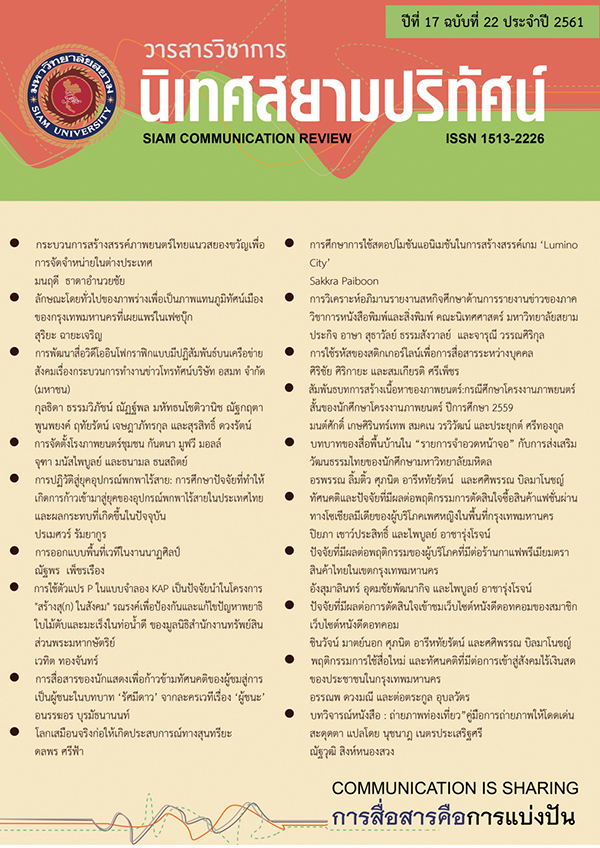The Role of the Folk Media “Cham Uat Na Cho” Programs and Thai Cultural Promotion by Mahidol University Students
Main Article Content
Abstract
In this thesis, the researcher studies (1) the exposure behaviors to the Cham Uat Na Cho television program of selected Mahidol University students. The researcher also examines (2) the perceptions of these students in respect to the folk media program contents. Moreover, the researcher considers (3) how the students utilized the contents of the program. Furthermore, finally, the researcher investigates (4) the role of the program in promoting Thai culture for the students.
The sample population consisted of 400 undergraduates enrolled at Mahidol University. Using techniques of descriptive statistics, the researcher analyzed the data collected in terms of frequency distribution, percentage, mean, and standard deviation. In the testing of hypotheses, the researcher employed a t test technique and the one-way analysis of variance (ANOVA) technique, as well as the chi-square (χ2) and Pearson’s product moment correlation coefficient (PPMCC) methods. Findings are as follows:
The sample population consisted of more females than males. The highest proportion studied in the science and technology faculties. They were studying in the second year of their programs with the highest proportion having domicile in Bangkok Metropolis and its environs.
In regard to program exposure behaviors, it was found that the highest proportion of the members of the sample population were exposed to the program through its presentation on Channel 1’s “Workpoint” at the time the program had on-air presentations (Sundays). The frequency of viewing of the program was not monthly, but rather only occasionally and never did they view previously televised programs. The most favored segment of the program was the “Choi Series.” Insofar as concerns viewing characteristics, they only viewed programs that interested them. They viewed the program for purposes of entertainment with family members.
In regard to the promotion of Thai culture by means of folklore media, the perceptions and satisfaction of the members of the sample population were at a high level. Next in descending order were the perceptions and satisfaction with the presentation of Thai uniqueness through live presentations of amusements, as well as program contents promoting Thai culture, customs, and traditions. The utilization of contents and knowledge obtained from the program in the aspect of Thai culture promotion through folk media was evinced at a high level. This enabled the members of the sample population at the highest level to become aware of the need to conserve Thai culture. Next in descending order were the stimulation of greater interest in Thai culture and relieving feelings of loneliness.
Concerning the perceptions and utilization of the contents of this program, this study showed that the members of the sample population could strongly perceive the role of the program as both a folk media and a mass media.
Article Details
References
ณรงค์ สมพงษ์. (2543). สื่อมวลชนเพื่องานส่งเสริม. กรุงเทพฯ: มหาวิทยาลัยเกษตรศาสตร์.
วรวุทธ สุวรรณฤทธิ์ และคณะ. (2549). วิถีไทย (พิมพ์ครั้งที่ 3). กรุงเทพฯ: โอเดียนสโตร์.
สมควร กวียะ. (2547). การสื่อสารมวลชน: บทบาทหน้าที่ เสรีภาพ และความรับผิดชอบ (พิมพ์ครั้งที่ 6). กรุงเทพฯ: โกสินทร์.
สำนักงานกองทุนสนับสนุนการสร้างเสริมสุขภาพ (สสส.) และโครงการสื่อพื้นบ้านเพื่อการสร้างเสริมสุขภาพชุมชน (สพส.) . (2548). สื่อพื้นบ้านสื่อสารสุข. กรุงเทพฯ: โรงพิมพ์มหาวิทยาลัยธรรมศาสตร์.
สำนักงานคณะกรรมการวัฒนธรรมแห่งชาติ. กระทรวงวัฒนธรรม. (2551). สื่อ: บทบาทและความสำคัญต่อการเผยแพร่งานวัฒนธรรม. กรุงเทพฯ: ชุมนุมสหกรณ์การเกษตรแห่งประเทศไทย.
อุบลรัตน์ ศิริยุวศักดิ์. (2550). สื่อสารมวลชนเบื้องต้น : สื่อมวลชน วัฒนธรรม และสังคม. กรุงเทพฯ: จุฬาลงกรณ์มหาวิทยาลัย.
West. R., & Turner. L. H. (2010). Introducing Communication Theory (4thed). NY: The McGraw-Hill.
Yamane. T. (1973). Statistics: an introductory analysis (3rded.). NY: Harper & Row.


